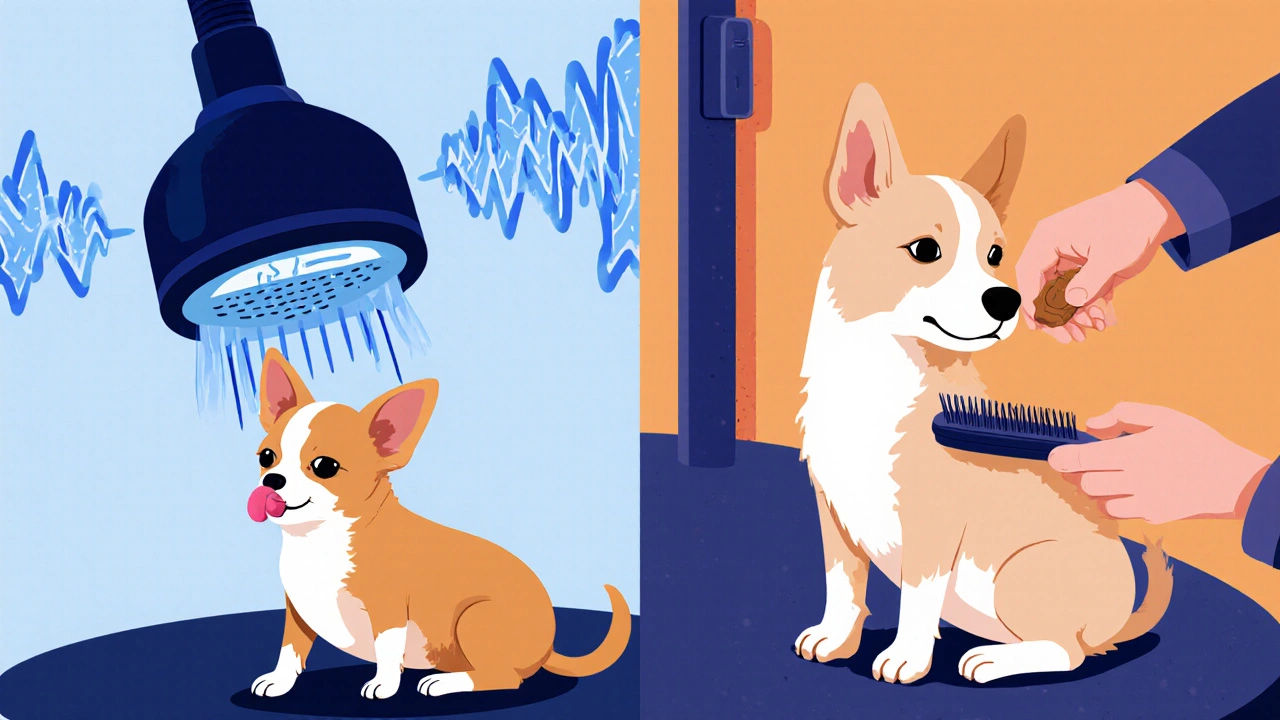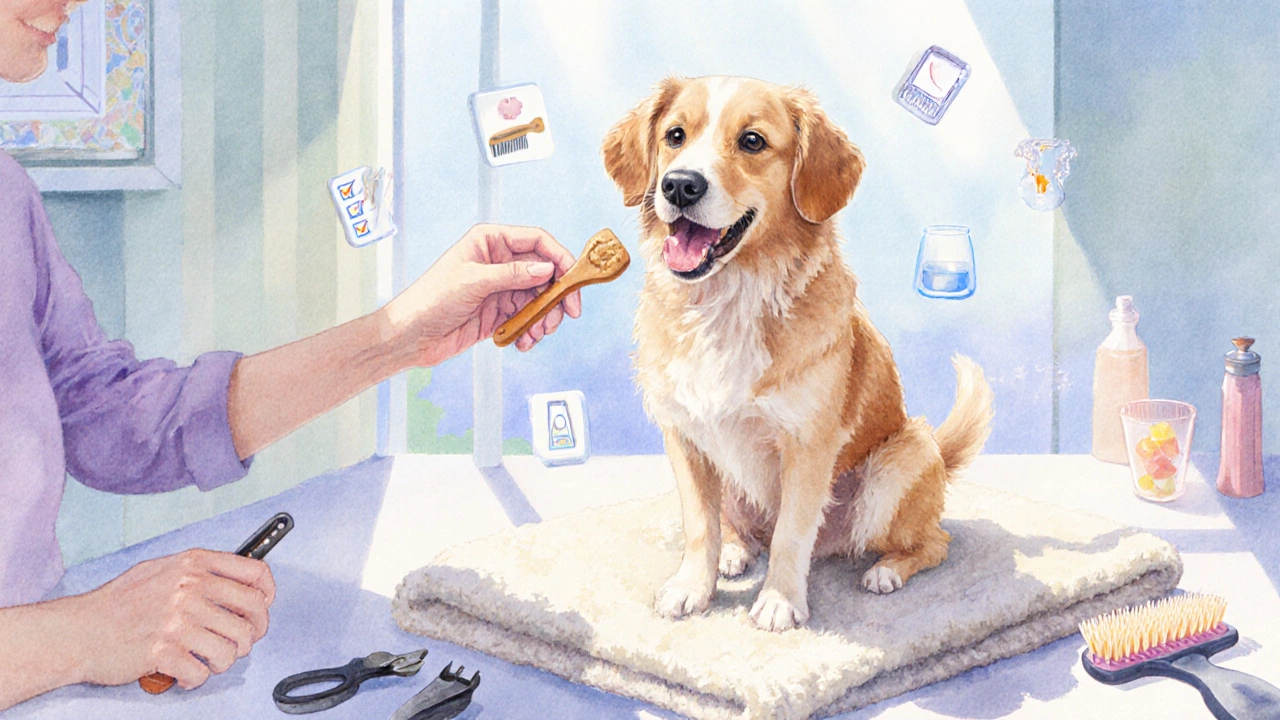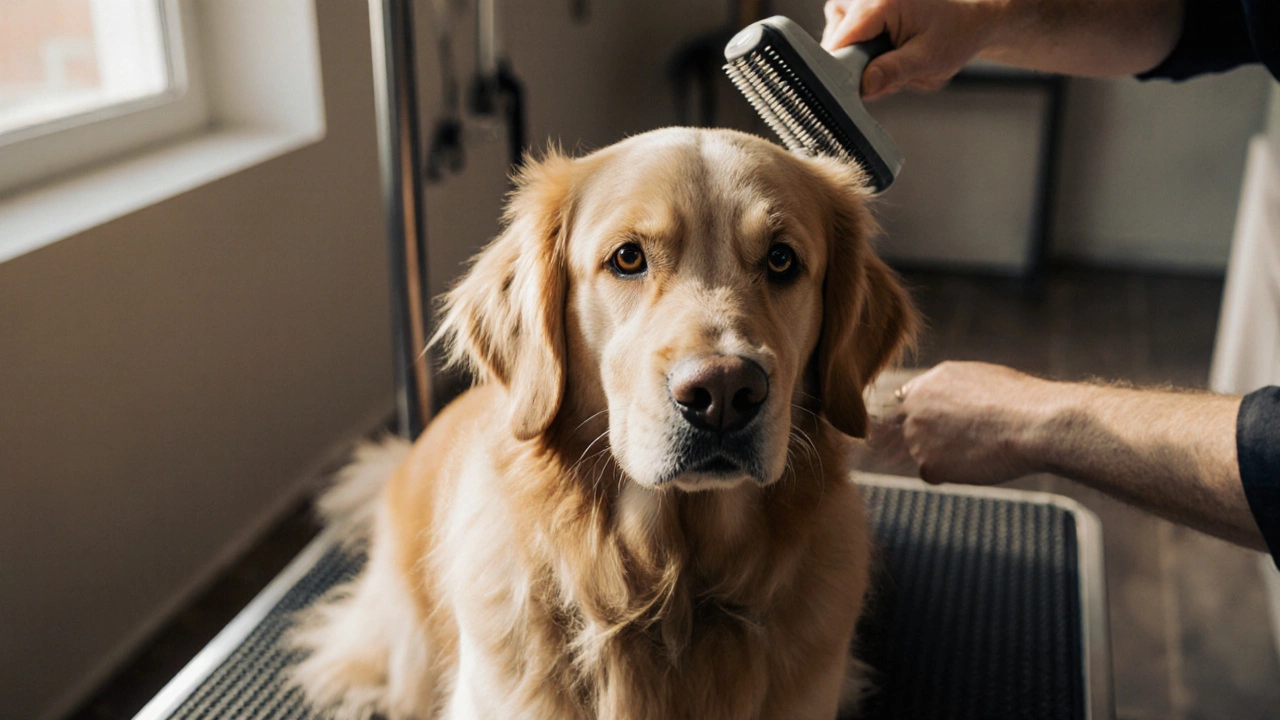Grooming Stress Assessment Tool
How Stressful is Your Dog's Grooming?
Assess your dog's stress level during grooming sessions based on behavior signals. This tool helps identify triggers and provides personalized tips to make grooming calmer.
When it comes to pet care, Dog grooming is the process of cleaning, trimming, and maintaining a dog’s coat, nails, ears, and skin often raises the question: do dogs cry during grooming? The short answer is yes-dogs can vocalize, whine, or even appear to "cry" when the experience is uncomfortable. But the story behind those sounds is more about stress, pain, or fear than actual tears. In this guide we’ll break down why a pup might whimper, how to tell genuine distress from normal grooming noises, and what you can do to keep the session calm and safe.
Key Takeaways
- Dogs don’t produce tears from emotion; they vocalize when grooming triggers anxiety or pain.
- Common stress signals include whining, lip‑licking, rapid panting, and avoidance behavior.
- Identify the root cause-sharp tools, loud dryers, or previous trauma-and address it before the next session.
- Positive reinforcement, desensitization, and proper equipment can turn grooming into a pleasant routine.
- Seek a Veterinarian if your dog shows signs of injury, excessive fear, or abnormal vocalization.
Do Dogs Actually Cry?
Unlike humans, dogs lack tear ducts that release emotional tears. Their eyes do produce a thin film of fluid for lubrication, but it never gushes out as a sob. What most owners interpret as "crying" is actually a combination of vocalizations (whining, howling, soft barking) and body language that signals discomfort.
When you notice a trembling whine while brushing a golden retriever’s undercoat, the dog is likely reacting to the sensation of the brush pulling on tangled hair. A high‑pitched whimper during nail clipping often means the clipper is hitting the quick-a sensitive blood vessel. In both cases the sound is a warning, not a tear‑filled sob.
Recognizing Real Distress vs. Normal Grooming Noises
Dogs have a rich vocal repertoire, so it helps to learn the difference between routine sounds and red‑flag alerts.
| Vocalization | Typical Context | When to Worry |
|---|---|---|
| Soft whine | Brush brushing, mild tugging | Escalates to louder whine or growl, ears back |
| Light bark | Excitement for water, bath start | Repeated barking with refusal to move |
| Gasping/panting | After vigorous shaking | Rapid shallow breaths, drooling, trembling |
| Howl | Playful response to dryer noise | Prolonged howl with avoidance |
Pay attention to accompanying body cues: flattened ears, tucked tail, lip‑licking, or a stiff posture indicate anxiety. If those signs appear alongside vocalizations, treat the session as a stress episode.

Common Triggers Behind Grooming‑Related Crying
Understanding the root cause lets you fix the problem before it escalates.
- Physical discomfort: Rough brushes, overly hot water, or nail clippers that press on the quick can all cause pain.
- Noise sensitivity: Many dogs are startled by the loud whirr of a dryer or the buzzing of electric clippers.
- Previous trauma: A past ear infection may make a dog flinch at ear cleaning, turning a simple wipe into a nightmare.
- Heat or cold: Leaving a dog in a chilly bathroom or using hot water that burns the skin triggers a stress response.
- Unfamiliar handling: Puppies or rescue dogs that haven’t been groomed often associate the process with loss of control.
Addressing each trigger involves a mix of equipment choices, environment tweaks, and behavior training.
How to Reduce Anxiety During Grooming
Here’s a step‑by‑step plan you can start using tonight.
- Choose the right tools. Use a slicker brush with soft bristles for short‑haired breeds and a wide‑tooth comb for long coats. Opt for nail clippers with a guard to avoid hitting the quick.
- Create a calm space. Groom in a quiet room, dim the lights, and lay down a non‑slip mat. A few minutes of gentle petting before you start can lower cortisol levels.
- Desensitize gradually. Let your dog sniff the brush or dryer while it’s off. Reward with treats when he shows curiosity instead of fear.
- Use positive reinforcement. Every 30‑second interval of calm behavior earns a small treat. Over time the dog links grooming tools with good things.
- Mind the temperature. Test water with your wrist before applying it to the dog. Keep the dryer on low and hold it at least 6 inches away.
- Take breaks. If your dog starts whimpering, pause, give a belly rub, then resume after a few breaths.
For breeds prone to anxiety-such as Chihuahuas, Greyhounds, or dogs with a history of abuse-consider a calming aid like a pheromone diffuser or a low‑dose prescription from a vet.

When to Call a Veterinarian
Most grooming anxiety can be managed at home, but certain signs warrant professional help.
- Bleeding from a nail clip or ear cleaning.
- Persistent whimpering that lasts beyond the grooming session.
- Sudden aggression, such as growling or snapping, especially if it’s a new behavior.
- Excessive drooling, vomiting, or shaking that may signal a severe stress reaction.
A Veterinarian can rule out underlying medical issues (like skin infections or arthritis) and prescribe anti‑anxiety medication if needed.
Checklist for a Calm Grooming Session
- Gather all tools: brush, comb, nail clippers, ear cleaner, towel, treats.
- Inspect the grooming area for loud appliances or sharp objects.
- Do a quick health check: look for hotspots, tangled mats, or sore spots.
- Start with a short play period to release excess energy.
- Introduce each tool slowly, rewarding calm reactions.
- Maintain a steady, gentle rhythm; avoid sudden movements.
- End with a favorite toy or extra treat to create a positive memory.
Following this list reduces the chance your dog will start "crying" during future grooming.
Frequently Asked Questions
Do dogs actually shed tears when they’re sad?
No. Dogs lack emotional tear ducts. What looks like tears is usually eye discharge from irritation or an infection.
Why does my dog whine only when I use the dryer?
The high‑frequency sound can be overwhelming for sensitive hearing. Try a lower setting, keep the dryer farther away, or use a softer towel‑dry method.
Can grooming cause long‑term anxiety?
If grooming consistently feels traumatic, a dog can develop a conditioned fear. Breaking sessions into short, rewarding steps can reverse that association.
My dog howls when I brush his ears. Is that normal?
Howling may signal discomfort or a prior ear infection. Examine the ear canal for redness or excess wax, and consult a vet if you see anything abnormal.
How often should I groom a dog that gets nervous?
Short, frequent grooming (once or twice a week) beats one long, stressful session. It builds tolerance and keeps mats from forming.
Is it safe to use human shampoo on my dog?
Generally no. Human shampoo can disrupt a dog’s skin pH, leading to irritation that might make grooming painful.
What role does Stress play in a dog’s grooming experience?
Elevated stress releases cortisol, which can heighten pain perception and cause a dog to vocalize more. Reducing stress lowers the chance of crying‑like sounds.
With the right tools, a calm environment, and a dose of patience, most dogs will transition from whining to tail‑wags during grooming. Remember, a "cry" is just a signal-listen, adjust, and make grooming a pleasant bonding time.
